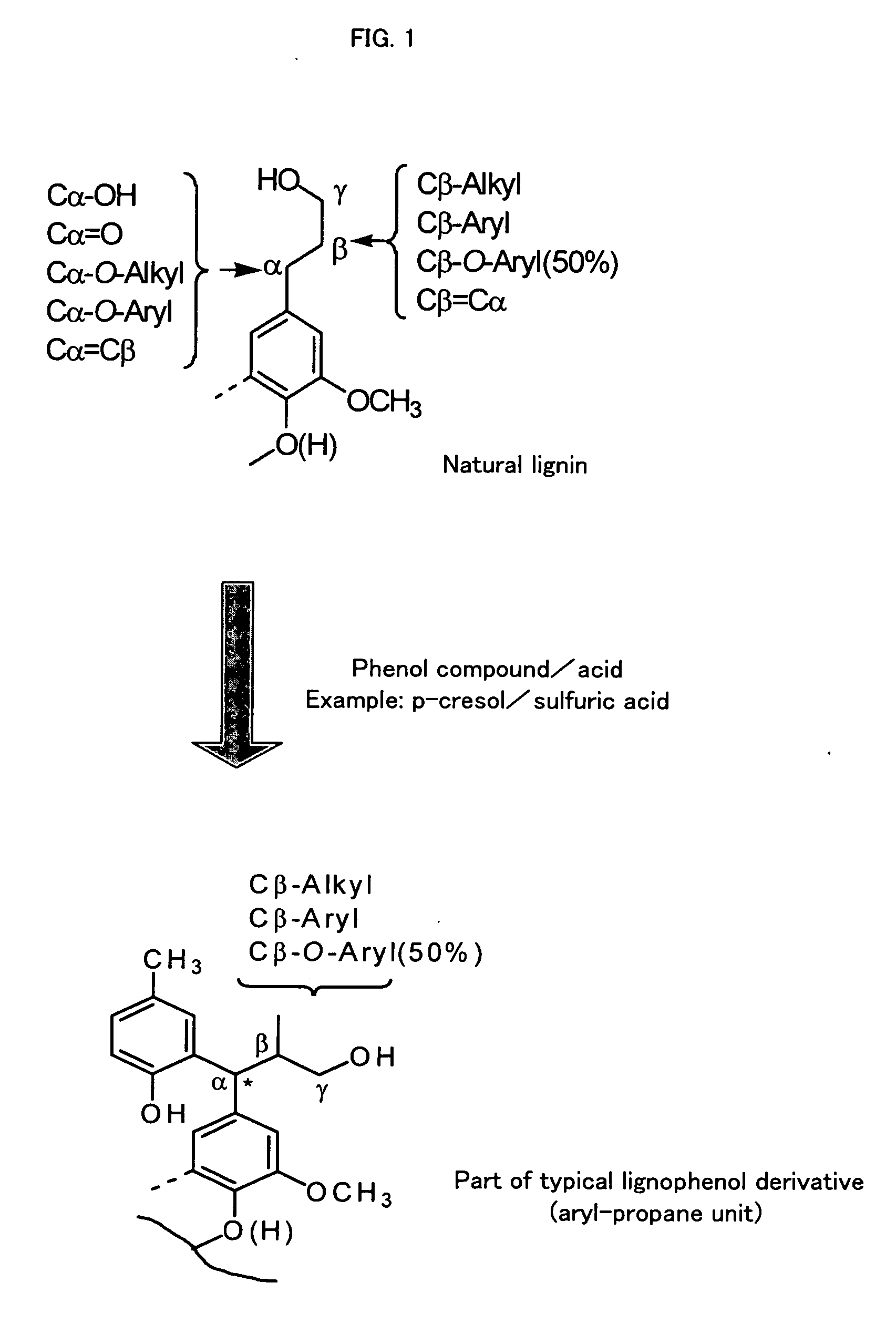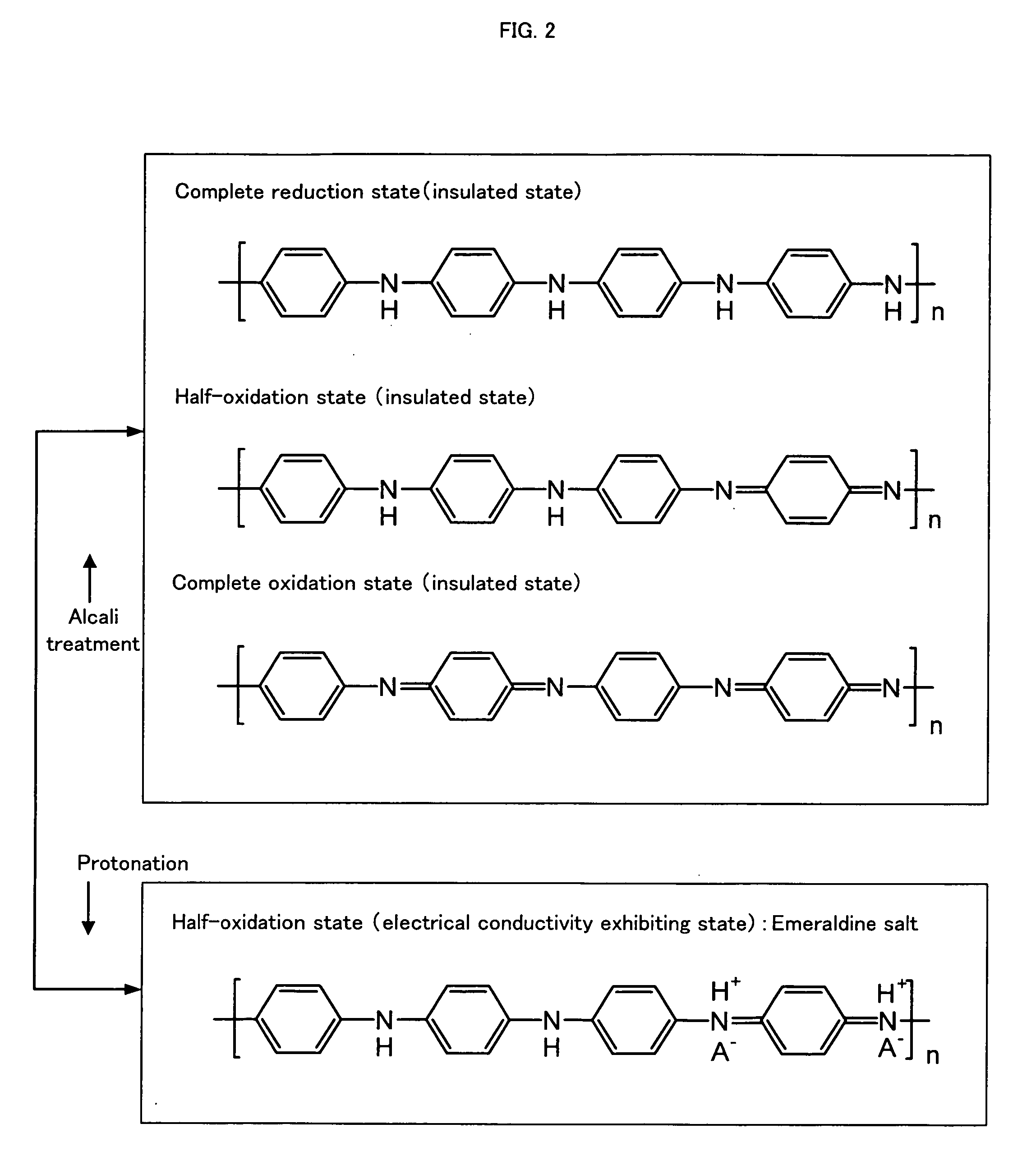Electrically Conductive Polyaniline Composition, Process for Producing the Same and Polyaniline Dopant
- Summary
- Abstract
- Description
- Claims
- Application Information
AI Technical Summary
Benefits of technology
Problems solved by technology
Method used
Image
Examples
example 1
[0142] Examples which are embodiments of the present invention will be explained below, but the present invention is not limited to the following Examples.
Preparation 1 of Lignophenol Derivative
[0143] About 1.0 g of a defatted sample of a wood flour (lignocellulose-based material) of Tsuga heterophylla was taken into a 50 ml-volume beaker, p-cresol (corresponding to a phenol compound at 3 mole-fold amount per lignin C9 unit) was added, and the mixture was stirred with a glass bar. Thereafter, 5 ml of 72 wt % sulfuric acid was added, this was vigorously stirred at 30° C. for 1 hour, and separated into two phases of phenol / acid by centrifugation (3500 rpm, 10 minutes, 25° C.), only the phenol layer was taken out, and placed into large excessive of ethyl ether, an insoluble section was dissolved in acetone, this was placed into large excessive of diethyl ether again, and a solvent was removed to obtain a lignophenol derivative (ligno-p-cresol) derived from Tsuga heterophylla.
example 2
Preparation 2 of Lignophenol Derivative
[0144] About 550 g of a defatted sample of a wood flour (lignocellulose-based material) of Tsuga heterophylla was taken into a 1000 ml-volume beaker, p-cresol (corresponding to 3 mole-fold amount per lignin C9 unit) was added to allow p-cresol to be permeated, 500 ml of 72 wt % sulfuric acid was added thereto, this was vigorously stirred at 30° C. for 1 hour, the mixture was placed into large excessive water, and an insoluble section was recovered by centrifugation (3500 rpm, 10 minutes, 25° C.), deacidified, and lyophilized to obtain a lignophenol derivative (ligno-p-cresol) derived from Tsuga heterophylla. Properties of the Tsuga heterophylla-derived lignophenol derivative obtained in Example 2 were such that a phenolic hydroxy group amount was 1.33 mol / C9 unit, an aliphatic hydroxy group amount was 0.58 mol / C9 unit, a phenol introduction rate was 0.75 mol / C9 unit, and a weight average molecular weight was 14200.
example 3
Preparation of Electrically Conductive Composition and Electrically Conductive Composite Material
[0145] Each 10 mg / ml N-methyl-2-pyrrolidone solution of two kinds of Tsuga heterophylla-derived lignophenol derivatives prepared in Example 1 and Example 2 was prepared. A 10 mg / ml N-methyl-2-pyrrolidone solution of basic polyaniline (manufactured by Aldrich) having a weight average molecular weigh of 20,000 was prepared. These respective solutions were added at once at a ratio shown in Table 1, and this was stirred and mixed for 24 hours to prepare a mixed solution of samples 1 to 5. A series of procedures were performed at room temperature.
TABLE 1Binding ratioLinear electrical conductivity(part by weight)(10−10Scm−1)LignophenolCompositePolyanilinederivativeFilmmaterial11001000.22180210030067.542231009000.241780410010037.931400510030041.738600Comparative10000.052ExampleControl0.14Example(5C filter)
[0146] In samples 1 to 5, when a blending ratio of a lignophenol derivative was 100 par...
PUM
| Property | Measurement | Unit |
|---|---|---|
| Percent by mass | aaaaa | aaaaa |
| Substance count | aaaaa | aaaaa |
| Substance count | aaaaa | aaaaa |
Abstract
Description
Claims
Application Information
 Login to View More
Login to View More - R&D
- Intellectual Property
- Life Sciences
- Materials
- Tech Scout
- Unparalleled Data Quality
- Higher Quality Content
- 60% Fewer Hallucinations
Browse by: Latest US Patents, China's latest patents, Technical Efficacy Thesaurus, Application Domain, Technology Topic, Popular Technical Reports.
© 2025 PatSnap. All rights reserved.Legal|Privacy policy|Modern Slavery Act Transparency Statement|Sitemap|About US| Contact US: help@patsnap.com



